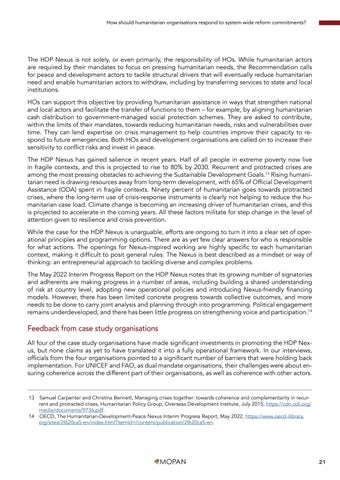How should humanitarian organisations respond to system-wide reform commitments?
The HDP Nexus is not solely, or even primarily, the responsibility of HOs. While humanitarian actors are required by their mandates to focus on pressing humanitarian needs, the Recommendation calls for peace and development actors to tackle structural drivers that will eventually reduce humanitarian need and enable humanitarian actors to withdraw, including by transferring services to state and local institutions. HOs can support this objective by providing humanitarian assistance in ways that strengthen national and local actors and facilitate the transfer of functions to them – for example, by aligning humanitarian cash distribution to government-managed social protection schemes. They are asked to contribute, within the limits of their mandates, towards reducing humanitarian needs, risks and vulnerabilities over time. They can lend expertise on crisis management to help countries improve their capacity to respond to future emergencies. Both HOs and development organisations are called on to increase their sensitivity to conflict risks and invest in peace. The HDP Nexus has gained salience in recent years. Half of all people in extreme poverty now live in fragile contexts, and this is projected to rise to 80% by 2030. Recurrent and protracted crises are among the most pressing obstacles to achieving the Sustainable Development Goals.13 Rising humanitarian need is drawing resources away from long-term development, with 65% of Official Development Assistance (ODA) spent in fragile contexts. Ninety percent of humanitarian goes towards protracted crises, where the long-term use of crisis-response instruments is clearly not helping to reduce the humanitarian case load. Climate change is becoming an increasing driver of humanitarian crises, and this is projected to accelerate in the coming years. All these factors militate for step change in the level of attention given to resilience and crisis prevention. While the case for the HDP Nexus is unarguable, efforts are ongoing to turn it into a clear set of operational principles and programming options. There are as yet few clear answers for who is responsible for what actions. The openings for Nexus-inspired working are highly specific to each humanitarian context, making it difficult to posit general rules. The Nexus is best described as a mindset or way of thinking: an entrepreneurial approach to tackling diverse and complex problems. The May 2022 Interim Progress Report on the HDP Nexus notes that its growing number of signatories and adherents are making progress in a number of areas, including building a shared understanding of risk at country level, adopting new operational policies and introducing Nexus-friendly financing models. However, there has been limited concrete progress towards collective outcomes, and more needs to be done to carry joint analysis and planning through into programming. Political engagement remains underdeveloped, and there has been little progress on strengthening voice and participation.14
Feedback from case study organisations All four of the case study organisations have made significant investments in promoting the HDP Nexus, but none claims as yet to have translated it into a fully operational framework. In our interviews, officials from the four organisations pointed to a significant number of barriers that were holding back implementation. For UNICEF and FAO, as dual mandate organisations, their challenges were about ensuring coherence across the different part of their organisations, as well as coherence with other actors.
13
Samuel Carpenter and Christina Bennett, Managing crises together: towards coherence and complementarity in recurrent and protracted crises, Humanitarian Policy Group, Overseas Development Institute, July 2015, https://cdn.odi.org/ media/documents/9736.pdf. 14 OECD, The Humanitarian-Development-Peace Nexus Interim Progress Report, May 2022, https://www.oecd-ilibrary. org/sites/2f620ca5-en/index.html?itemId=/content/publication/2f620ca5-en.
21



